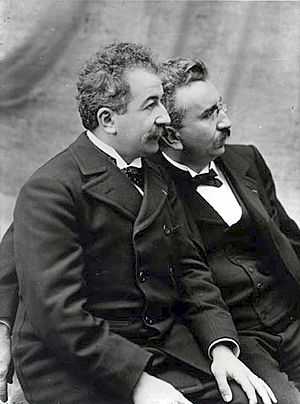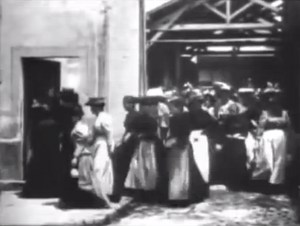Auguste and Louis Lumière facts for kids
Quick facts for kids
Auguste and Louis Lumière
|
|
|---|---|

Auguste (left) and Louis
|
|
| Resting place | New Guillotière Cemetery |
| Alma mater | La Martiniere Lyon |
| Occupation |
|
| Awards | Elliott Cresson Medal (1909) |
| Auguste Lumière | |
| Born |
Auguste Marie Louis Nicolas Lumière
19 October 1862 Besançon, France
|
| Died | 10 April 1954 (aged 91) Bandol, France
|
| Louis Lumière | |
| Born |
Louis Francis Patrick Jean Lumière
5 October 1864 Besançon, France
|
| Died | 6 June 1948 (aged 83) Bandol, France
|
The Lumière brothers, Auguste (born October 19, 1862) and Louis (born October 5, 1864), were French inventors. They are famous for creating the Cinématographe, a special camera and projector. They also made some of the very first movies between 1895 and 1905. This makes them pioneers of filmmaking.
Their first showing of a film was on March 22, 1895, in Paris. About 200 people saw this early movie projection. Many people consider their first public showing on December 28, 1895, as the official start of cinema. About 40 people paid to see this event. The Lumière brothers' ideas for showing films were more successful than others at the time.
Contents
The Lumière Brothers' Story
The Lumière brothers were born in Besançon, France. Their father, Charles-Antoine Lumière, ran a small photography studio. In 1870, the family moved to Lyon.
Auguste and Louis both went to La Martiniere Lyon, a big technical school in Lyon. They were very smart and interested in new inventions.
They created many important things that led to their film camera. One key invention was using small holes on the side of the film. These holes helped the film move smoothly through the camera and projector.
The Lumière brothers improved an earlier invention called the cinématographe. This amazing machine could do three things: it could record movies, develop the film, and project the movies onto a screen. They got their own patent for their improved version on February 13, 1895.
Historians are not sure exactly when their first film was made. Louis once said he shot it in August 1894. However, many experts believe their camera wasn't ready until early 1895.
The Lumière brothers thought movies were just a passing trend. By 1905, they stopped making films. Instead, they focused on inventing the first successful way to take colour photographs. This invention was called the Autochrome Lumière.
Louis Lumière passed away on June 6, 1948. Auguste Lumière died on April 10, 1954. They are buried together in a family tomb in New Guillotière Cemetery in Lyon.
First Movie Showings
On March 22, 1895, in Paris, the Lumière brothers showed a single film privately. It was called Workers Leaving the Lumière Factory. This showing was for a small group of people interested in new inventions. Louis Lumière was actually talking about colour photography that day. He was surprised that the moving black-and-white film got more attention than his colour pictures.
Their first public movie showing where people paid to watch was on December 28, 1895. It happened at the Salon Indien du Grand Café in Paris. They showed 10 short films:
- La Sortie de l'usine Lumière à Lyon (Workers Leaving the Lumière Factory), 46 seconds
- Le Jardinier (L'Arroseur Arrosé) (The Sprinkler Sprinkled), 49 seconds
- Le Débarquement du congrès de photographie à Lyon (The Photographical Congress Arrives in Lyon), 48 seconds
- La Voltige (Horse Trick Riders), 46 seconds
- La Pêche aux poissons rouges ("fishing for goldfish"), 42 seconds
- Les Forgerons (The Blacksmiths), 49 seconds
- Repas de bébé (Baby's Breakfast), 41 seconds
- Le Saut à la couverture ("Jumping Onto the Blanket"), 41 seconds
- Place des Cordeliers à Lyon (Cordeliers' Square in Lyon), 44 seconds
- La Mer (The Sea), 38 seconds
Each film was about 17 meters (50 feet) long. When cranked by hand, they lasted about 50 seconds.
In 1896, the Lumières took their cinématographe on a world tour. They visited many cities, including London, New York City, and Bombay. Their films were even shown in Egypt in November 1896.
Early Colour Photography
The Lumière brothers famously said that "the cinema is an invention without any future." Because of this, they refused to sell their camera to other filmmakers. This decision meant their time in the film industry was quite short.
However, they continued to work on colour photography. In 1903, they patented the Autochrome Lumière. This was the first practical way to take colour photographs. It became available to the public in 1907. For much of the 20th century, the Lumière company was a major producer of photography products in Europe.
Other Early Film Inventions
Before the Lumière brothers, other inventors were also trying to create moving pictures. Early systems often used hand-drawn images. But a system that could record real life in motion, like our eyes see it, had a bigger impact.
- Eadweard Muybridge created the Zoopraxiscope. It projected moving pictures based on his special photographs.
- Louis Le Prince went missing in 1890. He had been developing cameras and projectors and made a short film called Roundhay Garden Scene in 1888.
- William Friese-Greene patented a "machine camera" in 1889. He showed his results to photography groups in 1890.
- Thomas Edison also worked on moving pictures. He thought people would prefer to watch films in a special box called the kinetoscope. This device premiered in 1894. However, audiences preferred watching images projected onto a big screen.
- Max and Emil Skladanowsky invented the Bioscop. They showed projected moving images to paying audiences in Berlin starting November 1, 1895. Their films were shorter than the Lumière brothers'.
The Lumière brothers' invention became the most successful because it was easy to use and their films were longer and clearer.
Images for kids
See also
 In Spanish: Hermanos Lumière para niños
In Spanish: Hermanos Lumière para niños
- History of film
- L'Idéal Cinéma Jacques Tati in Aniche the oldest still-active cinéma in the world, though not continuously, since 23 November 1905.





